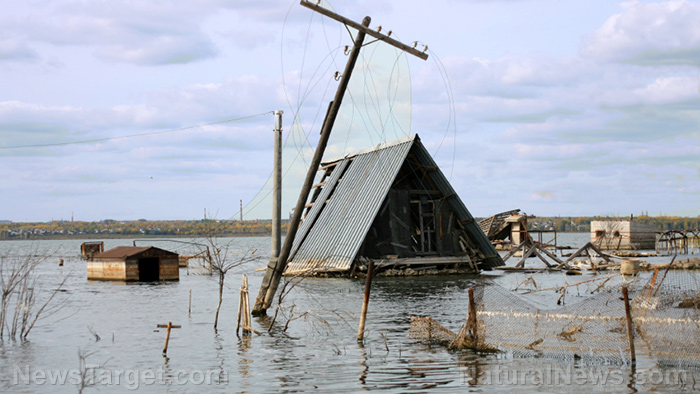
Advertisement
Floods are often caused by various factors such as heavy rain, hurricanes, or heavy snowfall that rapidly melts. Because of these factors, preppers know that it’s important to can make your home more flood resistant. (h/t to PrepperBits.com)
Start planning your flood preparations immediately because you don’t know when disaster will strike.
Protecting your property from flood damage
If you’re lucky enough to live in an area that rarely or never experiences flooding, that doesn’t mean you’ll never be affected by surface or groundwater flooding. Don’t wait until flooding becomes more likely before you start making the necessary preparations. (Related: Preparing for Disasters While Supplies Last.)
The tips listed below can help protect your property, and some of them may even save your life.
To prevent flood water from damaging your property:
- Air brick water defense – These specially designed air brick covers are easy to place over ventilation bricks. They will prevent water from getting in during a flood.
- Doors – Install purpose-built flood doors or temporary flood boards. You can also raise the thresholds of your external doors.
- Drains and pipes – To avoid sewerage pipes and drains from back-filling, fit non-return valves to drains and water inlet and outlet pipes.
- Walls and floors – Brick-built properties might benefit from raising the damp-proof courses and sealing floors and walls with a waterproof membrane to prevent water rising from the ground.
To protect the interior of your property and its contents:
- Baseboards/skirting boards – If you have the means to do so, install water-resistant baseboards/skirting boards. A cheaper alternative is to varnish them to protect against water damage to the boards.
- Doors and windows – Synthetic or waxed windows and doors can help prevent flood water damage. You can also varnish them for extra protection.
- Electrical flood protection – The height of controls, electrical wall sockets, fuse boxes, and wiring should be about least 1.5 meters above floor level. If you’re fitting/installing new electrical cables, run the cables down the wall to the raised socket so the cabling isn’t affected by flood water.
- Flooring – Fitting floor tiles are a better option instead of fitted carpets since the later will need replacing after a flood.
- Home entertainment – Secure audio-visual equipment (e.g. TV and hi-fi) to the wall at least 1.5 meters above the floor level.
- Interior walls – Some horizontal drywall/ plasterboard or lime-based plaster instead of gypsum can protect your interior walls. For cavity walls, install a cavity wall water management/drainage system to remove flood water with natural drainage channels or pumps.
- Kitchen and bathroom – Water-resistant materials like plastic, solid wood instead of a porous material (e.g. chipboard), or stainless steel will minimize water damage. Always increase the ground clearance of appliances like refrigerators with plinths.
- Shelving – Place valuable or irreplaceable items on high-mounted shelves to lower the risk of damage should your place get flooded.
- Sump pumps – Fitting a sump in the basement or the under-floor void of your home will help extract flood water.
You can make your home more flood-resistant using the tips above. Even if having a flood-proof home is next to impossible, remember that you should at least consider measures that can protect your property.
If you’re not sure how to start making your home more flood resistant, plan around a budget and the measures that suit your property type. When SHTF, it’s always better to be safe than sorry.
Supplies that you will need to survive a flood
Prepare the following supplies to ensure that you and your family stay safe during a flood:
- Food – You will need at least a three-day supply of non-perishable food like canned goods, dehydrated foods, and high-energy foods (e.g. granola bars, power bars, trail mix, and cereals). Don’t forget family members or pets who may require special foods like infant formula, baby food, food safe for diabetics, or pet food.
- First aid kit – Instead of buying a first aid kit, prepare one at home to make sure that it contains everything you might need during a medical emergency.
- Sanitation – To ensure good hygiene, always wash your hands and prepare the following: bleach, feminine hygiene items, hand wipes, personal hygiene items, toilet paper, and soap.
- Water – You will need water to stay hydrated. Store at least three days worth of potable water in plastic containers. An individual requires about one gallon of water for at least three days.
You can read more articles about how you can stay safe when SHTF at Preparedness.news.
Sources include:
Submit a correction >>
This article may contain statements that reflect the opinion of the author
Advertisement
Advertisements
















